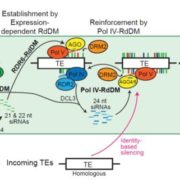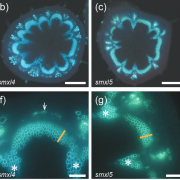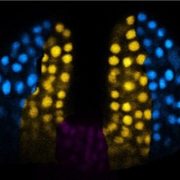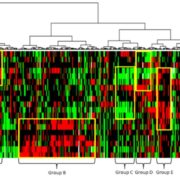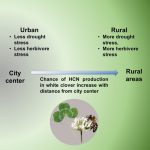A conserved superlocus regulates above- and belowground root initiation (Science)
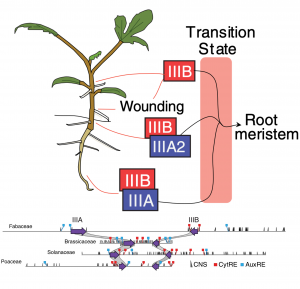 The vascular plant body composed of root and shoot is specified during embryogenesis, but most flowering plants can also develop additional root systems post-embryonically: lateral roots, as a response to wounding, or shoot-borne roots (“adventitious” roots, literally meaning “in the wrong place”). The initiation mechanism of these roots as well as their parent tissue and the ontogenic relationships between them are poorly understood. Since Arabidopsis thaliana rarely produces shoot-borne roots, Omary and colleagues used tomato (Solanum lycopersicum) to uncover the molecular basis of shoot-borne root initiation. Hormonal fluorescent reporters, single-cell transcriptomics and CRISPR null-mutants revealed that shoot-borne roots originate from differentiated phloem-associated cells that go through an uncharacterized transitory cell identity: from differentiated phloem to root meristem. Subsequent analysis pointed towards a LBD transcription factor whose null-mutant phenotype resulted in stems and hypocotyls completely lacking roots, thus was named SHOOTBORNE-ROOTLESS (SBRL). Strikingly, phylogenetic analysis of SBRL orthologs and loss-of-function mutants of potato (Solanum tuberosum) SBRL revealed that the regulation of the shoot-borne root initiation program by IIIB LBDs (a subclass of LBDs) is deeply conserved within angiosperms. In analyzing the genomic regions of IIIB LBDs orthologs, the authors found that they are almost always found in a “superlocus” that also contains IIIA LBDs and conserved auxin and cytokinin response cis elements. The double mutant sbrl bsbrl (BROTHER OF SHOOTBORNE-ROOTLESS, the syntenic IIIA LBD adjacent to SBRL) completely lacks shoot-borne roots and displays a significant reduction in lateral roots, indicating that IIIB and IIIA LBDs function in root initiation in different contexts. This fascinating paper describing how a deeply conserved angiosperm superlocus employs individual paralogs to regulate the initiation of postembryonic roots in different developmental contexts and is a valuable contribution for understanding the genetic programs underlying different types of root systems. (Summary by Jesus Leon @jesussaur) Science 10.1126/science.abf4368
The vascular plant body composed of root and shoot is specified during embryogenesis, but most flowering plants can also develop additional root systems post-embryonically: lateral roots, as a response to wounding, or shoot-borne roots (“adventitious” roots, literally meaning “in the wrong place”). The initiation mechanism of these roots as well as their parent tissue and the ontogenic relationships between them are poorly understood. Since Arabidopsis thaliana rarely produces shoot-borne roots, Omary and colleagues used tomato (Solanum lycopersicum) to uncover the molecular basis of shoot-borne root initiation. Hormonal fluorescent reporters, single-cell transcriptomics and CRISPR null-mutants revealed that shoot-borne roots originate from differentiated phloem-associated cells that go through an uncharacterized transitory cell identity: from differentiated phloem to root meristem. Subsequent analysis pointed towards a LBD transcription factor whose null-mutant phenotype resulted in stems and hypocotyls completely lacking roots, thus was named SHOOTBORNE-ROOTLESS (SBRL). Strikingly, phylogenetic analysis of SBRL orthologs and loss-of-function mutants of potato (Solanum tuberosum) SBRL revealed that the regulation of the shoot-borne root initiation program by IIIB LBDs (a subclass of LBDs) is deeply conserved within angiosperms. In analyzing the genomic regions of IIIB LBDs orthologs, the authors found that they are almost always found in a “superlocus” that also contains IIIA LBDs and conserved auxin and cytokinin response cis elements. The double mutant sbrl bsbrl (BROTHER OF SHOOTBORNE-ROOTLESS, the syntenic IIIA LBD adjacent to SBRL) completely lacks shoot-borne roots and displays a significant reduction in lateral roots, indicating that IIIB and IIIA LBDs function in root initiation in different contexts. This fascinating paper describing how a deeply conserved angiosperm superlocus employs individual paralogs to regulate the initiation of postembryonic roots in different developmental contexts and is a valuable contribution for understanding the genetic programs underlying different types of root systems. (Summary by Jesus Leon @jesussaur) Science 10.1126/science.abf4368


